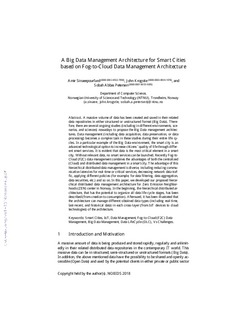| dc.description.abstract | A massive volume of data has been created and saved in their related
data repositories in either structured or unstructured format (Big Data). There-
fore, there are several ongoing studies (including in different environments, sce-
narios, and sciences) nowadays to propose the Big Data management architec-
tures. Data management (including data acquisition, data preservation, or data
processing) becomes a complex task in these studies during their entire life cy-
cles. In a particular example of the Big Data environment, the smart city is an
advanced technological option to increase citizens’ quality of life through differ-
ent smart services. It is evident that data is the most critical element in a smart
city. Without relevant data, no smart services can be launched. Recently Fog-to-
Cloud (F2C) data management combines the advantages of both the centralized
(Cloud) and distributed data management in a smart city. The advantage of this
hierarchical distributed data management is diverse, including reducing commu-
nication latencies for real-time or critical services, decreasing network data traf-
fic, applying different policies (for example, for data filtering, data aggregation,
data securities, etc.) and so on. In this paper, we developed our proposed hierar-
chical distributed data management architecture for Zero Emission Neighbor-
hoods (ZEN) center in Norway. In the beginning, the hierarchical distributed ar-
chitecture, that has the potential to organize all data life cycle stages, has been
described (from creation to consumption). Afterward, it has been illustrated that
the architecture can manage different obtained data types (including real-time,
last-recent, and historical data) in each cross-layer (from IoT devices to cloud
technologies) of the architecture. | nb_NO |

